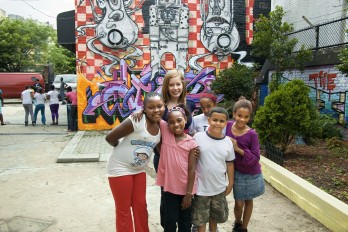COVER STORY
Students in the College of Architecture, Art and Planning at work in the second-floor studio space at 50 W. 17th St.
Students take on the Big Apple -- Cornell's urban lab
"Most of the courses are taught in the evening by industry practitioners," she says. "There are not that many books written on algorithmic trading, but it's so hot right now. What we offer here is two people, one from a hedge fund and one from J.P. Morgan, who come and teach a class." They are the leaders in their field, she says, but could never find the time to travel to Ithaca.
At this stage of the program, the students alternate between classes and a semester project consulting in teams for financial companies. Graduate student Sharath Alampur's team is working on a question posed by Goldman Sachs. The company wants a mathematical model that can replicate the return of a mutual fund, but without fund managers.
"You can get close to a mutual fund type of return but you can avoid the fees" -- and profit handsomely from the advantage, he says.
Meanwhile, the College of Architecture, Art and Planning, which leased a studio in the Chelsea neighborhood of Manhattan in 2006, is now giving more students affordable access to the center of the design world and the people who dominate it. The college is seeking to raise $12 million to endow its Manhattan operation.
Architecture student Tim Liddell '10 spent a semester at the AAP center in Rome before his semester in New York City, and he says both are worlds away from his upbringing on a farm in Lancaster, Pa.
"It's all about location," he says. "It's a huge benefit to be in the midst of all this. I've never lived in any real urban context, so this is an entirely new experience -- it's a chance for me to figure out what to do after Cornell and whether this is a city where I'd like to live and work."
Just one book
The urban context that Lillian "Lily" Wood '11, a human development major, encountered last summer could not have been further away from high finance or architectural design.
As part of the Urban Scholars Program, Wood worked with a community-development organization in the South Bronx. The neighborhood it serves is the birthplace of hip-hop music, and according to the U.S. Census, is among the poorest parts of New York City.
Wood helped organize a literacy program for young teens and pre-teens in a neighborhood where almost all children eat free lunch and breakfast every day at local schools, and many suffer from asthma, possibly because of diesel exhaust from the 15,000 tractor-trailers that rumble through neighborhood streets each day. Getting them enrolled in a seven-weeklong summer day camp proved difficult because many parents couldn't afford the $275 fee, Wood says.

Lillian Lily Wood 11 with students at The Point, a community development organization in the South Bronx this past summer that she worked with as part of the Cornell Urban Scholars Program. See larger image
Her program's center of operations was a narrow loft space, maybe 10 feet by 25 feet, with big dry erase boards bearing the names of the student literacy teams -- Da Champs, Blue Angels, Jaguars and Hyper Tyranus Unleashed.
The goal of the program, which tries to make reading exciting through games and competition, was modest for a student accustomed to Cornell's driven academic culture: To have each child finish just one book, either "Holes" by Luis Sachar or "The Phantom Tollbooth" by Norton Juster, by the end of the summer.